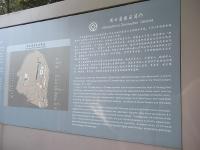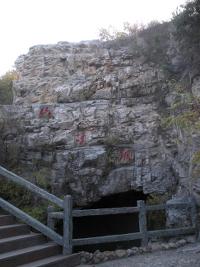***
N. China
Day 2 - 31st October - Zhoukoudian (Part 2)
My train tickets having been bought, I set out for the Peking Man Site at Zhoukoudian.
As has been reported, the site is difficult to reach and not that popular; Fodor's and Frommer's ignored it and I only found directions in Let's Go (from 2005, which while including Chinese characters of attractions, didn't include them for directions). I was to take the 917 to Fangshan (房山 - luckily the characters were simple) and then take a taxi. I was supposed to take it from 天桥 (Tianqiao) station, but the hostel people had been unable to find it on the map so they had advised me to take it from another station.
917 was an extremely frequent bus, with one departing seemingly every new minutes. Unfortunately, this was because it had what seemed like 3-6 different variants, so I ended up being kicked from bus to bus (once I was pointed to a wrong spot twice), and bus drivers and conductors kept pointing me to parts of each bus stop to take the correct bus. I had to go up 3-4 buses before I got the correct one (just in time to see that I had missed the bus with "房山" listed as the other terminus).
Happily, there was one seat at the last row of the bus I finally took, in a corner. I wanted to squeeze in, but the people sitting in the row moved in. Fortuitously, the guy beside me was going to Zhoukoudian as well (he lived 5 minutes away), and he recommended a different set of directions which were presumably better (or more updated) than Let's Go (and said I could follow him). I told him I wanted to see "北京人" ("Peking Man", literally) and he seemed amused because of an ambiguity in translation - "北京人" can translate as "inhabitant of Beijing", though it is also used as a name for Peking Man. A more precise term would be "北京猿人" ("Peking Ape Man"). He asked me if I had seen BJ's other sights, and cutting a long story short I said I wanted to escape the crowds.
On the way to Fangshan, the bus passed the Marco Polo bridge. Besides being Beijing's oldest bridge (1189 - Jin dynasty), it is also famous for the Marco Polo "Incident". From a distance, it looked very unimpressed and ugly - and I sure couldn't see the stone lions.
Here're some pictures from other people. It is slightly better close up, it seems:



When I opened Let's Go, the guy who I was following asked me what language it was in, and asked if it was "新加坡文" (Singaporean).
Road sign near Marco Polo bridge: "Macau, 2312 km". Okay.
There were a lot of high concrete pylons by the roadside. I asked my companion and he said that they were for a high speed train line to 石家庄 (Shijiazhuang), which was 400km away. The train, when ready in 2 years, would connect it to Beijing in 1 hour, so I was quite sure it would be a maglev line. Later research reveals the city is only 280km from BJ (and is the capital of Hebei too). Amusingly, each pylon had a word of encouragement apropos its completion.
There was a 大石河 (Big Stone River) at one point, but it had no water. My companion said it was a dry river and even the summer rains could not make it wet.
When I got to Zhoukoudian I think my companion invited me to his house, but I declined as it was already 1pm. He didn't insist, so I guess he was not trying to sell me stuff.

Zhoukoudian sign

Apparently the Olympic Flame came here

Zhoukoudian square

From caves... to Chinese Civilization

Site entrance

Site information plaque


Site award plaques. Note especially the last, which reads:
"培育爱国之情,激发报国之志
全国爱国主义教育示范基地"
("Nurturing the love of country, arousing the will to dedicate oneself to the country
Nationwide patriotic education key site")
Naturally, the Chinese have to politicise everything.

Metal plaque with more site information
The site offered an audioguide. However, I only discovered this by chance, by reading an unremarkable plaque at the side of the path which mentioned that a deposit had to be paid for the audioguide (and which listed other terms); even at the ticket booth, there was no sign or indication that there was an audioguide. Indeed, I was the only one using the audioguide - presumably no one else noticed the sign (or, at least, wanted to pay).
There was a small sign saying that in 1992 Zhoukoudian was labelled one of the most popular sites in Beijing. So why was it so hard to get there? That said a minimap of it was on my Beijing Map, so you know it's important and/or popular.


"Peking Man came back to the cave after hunting"


Pigeon Hall


Locality 1 - Peking Man Site. This is where they found the best stuff (which unfortunately disappeared during the war)

Rock profile

Pigeon Hall from Locality 1

"The first skull-cap of pekingMan was discovered here in 1929"


Evil, fat cat

"小草微微笑
行人把我绕"
("The little grasses smile,
Pedestrians make a round around me"
Yes, PRCs destroy the grass in their country too.

There was a mechanism to bring buckets (presumably of dig material) down from a height. This platform looked like it was to sort the material on, which was strange. I'd have imagined material would be sorted indoors, in a more comfortable setting. Perhaps this platform was built to raise morale, as its sides were decorated with pictures of the sites, recalling past glories.

UNESCO plaque outside museum
I decided I could do the museum later, when the light outdoors was less bright.

Recycling bins: "Recycled" and "Organism"
The audioguide was not very well planned, so I was rather lost about where I should be listening to which commentary (the usual practice is to have numbered panels to guide you, but this place relied on audio instructions that ranged from vague to non-existent), so I just listened to everything at once. The audioguide was also not produced very well, as the audioguide talked about "querying the fossils". Perhaps someone had the Stories-Bones-Tell ability.
The enthusiasm of the audioguide was evident, though, as the girl waxed about Chinese patriotism-related topics, and described how a scientist was working with candlelight at 2+ (PM, I think) and made a startling discovery.


Upper Cave Man Site


Upper Cave Man Site


Wooly Rhino
There was a couple there with a very cute puppy:


It was 20+ days old, and I they used what sounded like the Chinese term for Chihuahua ("吉娃娃"/"芝娃娃")

"Caution! Cliff!"
The audioguide called Pearl Harbor the 'Pearl Harbor Incident'. Uhh...

Thick-jawed deer

Site 4


Site 4 Cave


Cap Deposit
Cap deposit
Peking Man used fire, but he did not make fire. He took natural fire and tended it in his



Simulated archaeological dig - only during the summer though
For some reason there was an earthquake museum there too. It featured earthquake scientists. The first was Chang Heng (Zhang Heng), who invented the world's first Seismograph in 138 AD. The next earthquake scientist came only 17 centuries later.


The World's First Seismograph. A copper ball will fall into the mouth of the toad in whose direction the earthquake came.
The museum was incomplete and there was still work being done in it (the workman inside who I talked to didn't know when it would open, if it was being renovated or rebuilt and stuff like that). Almost all material was in Mandarin, which made it painful to read, but I did manage to glean that they perpetuated the myth of animals predicting earthquakes! Another panel drew a relationship between earthquakes and water freezing. Okay.
Great view of nothing- the singularly unspectacular view from the meteorological station. Height is not everything.
The earthquake museum was very holistic, as it talked about CPR ad first aid. There were even CPR dummies. There was also an earthquake simulation platform. Unfortunately it was not working - and anyway it didn't look like you could sit on it.